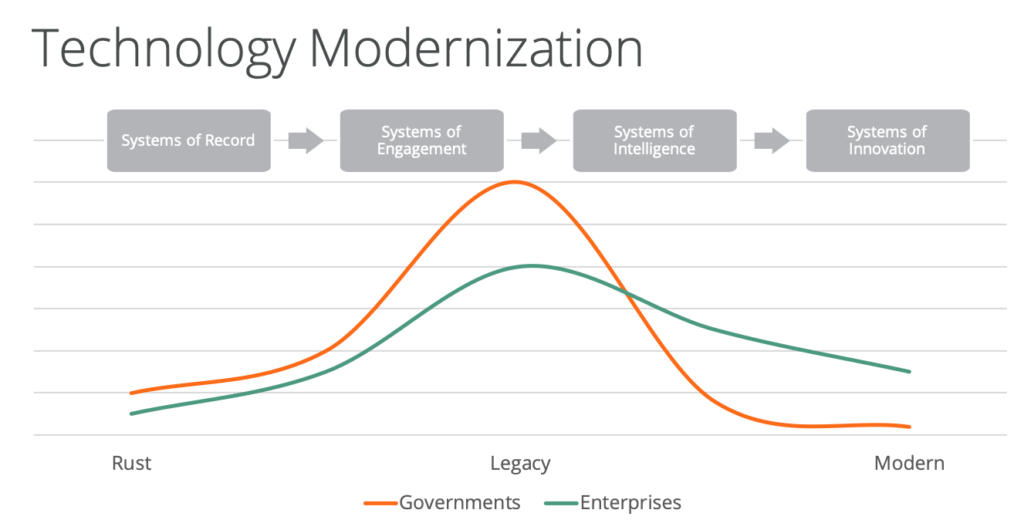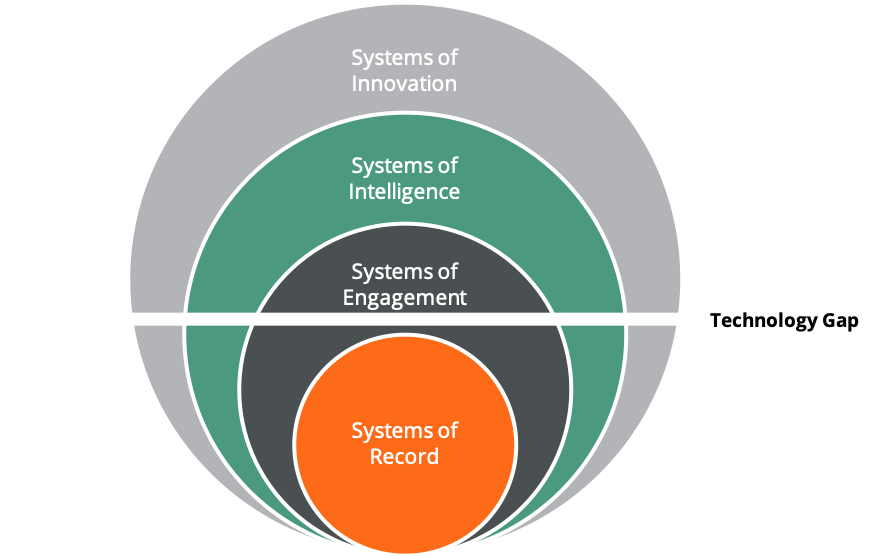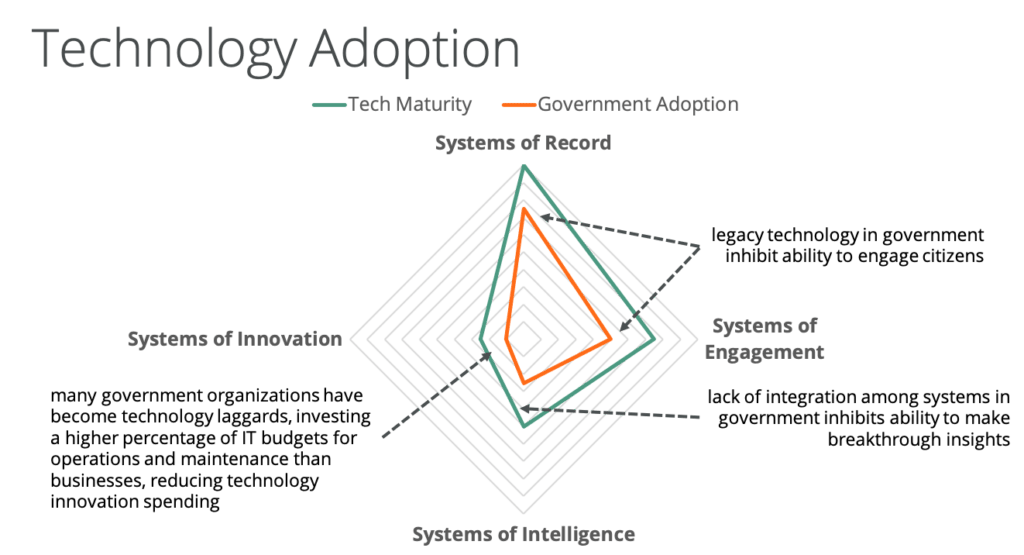Modern technology enables government digital transformation. It’s governance transformation in pursuit of sustainable and equitable economic growth. Governments migrate from dogma to evidence. From unwieldy bureaucracies to agility. Technology enables this drive from Systems of Record to Systems of Innovation.
Core Technologies for Government Digital Transformation
Evidence shows that digital transformation scales when organizations build technology platforms. Underlying technology scales smart government and open government initiatives.

*Systems of Innovation in dark red
The technology foundations for digital phases in government are:
- Systems of Record: core information systems that provide transactional data, transaction management, workflow, documents, and controls
- Systems of Engagement: information systems designed for two-way communications, and new forms of data collection, often called SMACT (Social, Mobile, Analytics, Cloud, and Internet of Things), or what analysts, the Gartner Group calls “the Nexus of Forces”, and IDC calls “the Third Platform.”
- Systems of Intelligence: information systems designed to make sense of information flow in new ways:
- Big Data: analysis of data from multiple sources from systems of record integrated with systems of engagement such as structured data, documents, audit training, social media activity and the Internet of Things
- AI & RPA: artificial intelligence, machine learning and Robotic Process Automation to augment human capabilities
- Data Science: methods to analyze and visualize information
- Low Code/No Code: facilitating configuration and customization of information systems
- Systems of Innovation: information systems designed for governance breakthroughs leveraging emerging technologies of:
- Augmented Reality and Virtual Reality: facilitating information visualization
- Blockchain: augmenting trust digitally
- Agile Collaboration: facilitating collaboration among government organizations, citizens, non-profit and business stakeholders, external governments, and international institutions
- Sharing Economy: facilitating value transfer and sharing
- Cyber-Physical Systems: enabling the “fourth industrial revolution” of unparalleled productivity and customization, particularly for smart government and smart cities

Generally, core technologies from one phase support future phases. Core technologies are often upgraded to support the needs of more advanced phases. For example, database management technology in support of Systems of Record was primarily based on relational databases and support for SQL. Multi-dimensional OLAP databases were developed to support reporting and analytics in the phase. NoSQL, XML, and columnar databases augment previous core technologies to support Systems of Engagement and Systems of Intelligence.
Many organizations, governments included, remain on the SMACT sidelines, with limited use of systems or intelligence and innovation. Government organizations tend to be technology adoption laggards compared to the business mainstream.
The diagram below conveys some of the technology linkages between these “systems of engagement” and “systems of intelligence”. The important takeaway is that effective use of technologies at one level of maturity enables further levels. That’s where this concept of platform comes in: to overcome technology gaps.

Technology Generations for Government Digital Transformation
Core Government Resource Planning (GRP) and Government Technology (GovTech) solutions represent generations of platforms and IT thinking. Core technologies, or core technology concepts, from one generation, support the next generation. However, technology structures and deployment mechanisms differ across these generations.

Computing technologies improve over time. Core enterprise technologies from the late 1990s, such as leading Enterprise Resource Planning (ERP) systems that require code customization to meet customer requirements were defined by the Gartner Group as “legacy”. Gartner predicted in 2014 that the shift to cloud computing and more adaptable systems would become the “postmodern” norm by 2016. New technology approaches have emerged in the past decade.
These technology generations include:
Deployment
Legacy: from web-enabled client/server, to…
- Postmodern: web-native (no client/server base), to…
- Emergent: cloud-native to support any combination of public and private cloud deployment and scalability.
Government Implications: almost all Enterprise Resource Planning (ERP) systems use client/server technologies that are expensive to adapt and maintain making for a high Total Cost of Ownership (TCO) and poor financial sustainability.
Architecture
Legacy: from monolithic approaches with large modules, to…
- Postmodern: component-based service-oriented architectures with shared small business components, to…
- Emergent: microservices to scale down to small modules and scale up to elasticity.
Government Implications: almost all ERP systems leverage monolithic approaches making it difficult to effectively deploy on any combination of government-shared services and public cloud infrastructures.
Integration
Legacy: from proprietary integration methods within product suites, to…
- Postmodern: support of open and established integration standards, typically using metadata management tools, to…
- Emergent: unified approaches thanks to small business components with a single point of metadata management.
Government Implications: almost all ERP systems primarily leverage proprietary integration methods making interoperability very difficult with other financial subsystems in use.
Adaptability
Legacy: from code customization, to…
- Postmodern: configured systems, to…
- Emergent: ease of adaptability with the combination of low-code and no-code methods.
Government Implications: governments tend to use highly customized applications making it difficult and expensive to support future reform and modernization – what we call progressive activation.
Market
Legacy: from “horizontal”, generic, and multiple industry markets with the emergence of ERP in the 1990s that leveraged functionality from one market to others to achieve economies of scale, to…
- Postmodern: vertical market specialized systems because legacy systems, like ERP, require so much customization, to…
- Emergent: specialized sub-vertical markets, such as supporting the government sub-vertical of the public sector vertical
Government Implications: governments now have a choice for Commercial-Off-The-Shelf (COTS) “best of breed” enterprise-class software, designed specifically for the government, like the FreeBalance Accountability Suite™ that is easier to understand, adapt, and less expensive to maintain.
Foundational Implications for Systems of Record to Systems of Innovation
The legacy of postmodern to emerging technology structure somewhat aligns with the “systems of” view of digital transformation:
Systems of Record: this generation provided utility in constrained environments of limited computing power, storage and bandwidth requiring clever solutions including:
- Client-Server: mechanisms to leverage the power of central computers and desktop systems to overcome cost/performance limitations of mainframe computing
- Web 1.0: characterized by the initial deployment of business and government technologies on the web, characterized by web enablement by pushing user interfaces from desktop operating system functions to browsers*
- Proprietary technologies: business systems relying on programming languages like FORTRAN and COBOL were unable to meet the needs of the 1990s, so enterprise software firms developed focused new languages and architectures*
- Monolithic architectures: purpose-built architectures were required to support customer requirements in the 1990s era of technology implementation*
- Customization: support for unique requirements was supported by adapting the underlying code of enterprise systems*
- Horizontal focus: systems of record began to support multiple vertical markets with solutions like Enterprise Resource Planning (ERP), Customer Relationship Management (CRM), Supply Chain Management (SCM), and other “three-letter acronyms” to extend functionality*
*Yes, many enterprise software systems in use today, with the most recent versions, include these characteristics.
Systems of Engagement: this generation leveraged the Internet to scale interactions and support social media, and e-commerce:
- Web 2.0: web-native approaches in enterprise software provide scaling, and integration with activity streams like social media, and IoT devices
- Service-Oriented: mechanisms to share functionality across enterprise applications
- Open Systems: with fewer technology constraints, new technology is developed as open systems, often using robust open-source components, accelerating product innovation
- Postmodern: the ability to deploy enterprise software on-premises, private cloud, and public cloud with identical code gives governments a choice
- Quick Starts: complexity with code customization led many COTS vendors to provide templates to accelerate implementations
- Vertical: increasing recognition of differences among vertical markets, particularly in the public sector, saw a shift to more specialized solutions
Systems of Intelligence: this generation leverages technology to make better sense of information, and to better integrate:
- Web 3.0: support for a set of new web technologies, mobile apps, an increased set of information types, and integration methods
- Unified: integration has become more complex with new information sources, especially when many vendor suites require complex metadata management for intra-suite integration, shifting software architectures to…
- Assembled: the move from monolithic suites, towards open systems, and increasing service orientation in enterprise software enables the assembly of application functionality from underlying components
- Configured: enterprise software is becoming more configurable, replacing what was once code customization – with no-code and low-code integrated within product suites emerging in this phase
- Micro-Verticals: increasing recognition of differences within vertical markets, such as the difference between government and non-profit functionality within the public sector vertical, creates more specialized applications
Systems of Innovation: information systems designed for breakthrough governance improvements, where new patterns are emerging
- Post Web: enterprise software is moving beyond web and app interfaces to voice, and physical interfaces
- Software-Defined Everything: the logical extension of technology is adaptive hardware through software configuration
- Linked: integration with external data within operational
- Composed: logical extension of assembling functionality from existing applications, to composing enterprise applications from existing and public cloud applications
- Massively custom: ability to create and maintain highly custom applications without the burden associated with code customization through linked data, composed applications, and no-code configuration
Technology generations motivate the updating of core technologies. For example, improvements in database management technology support Systems of Engagement, but improvements in client-server technology have very little benefit in supporting additional stages.
Government Digital Transformation Enablement Benchmark
Governments that have fallen behind in technology adoption have leapfrog opportunities. These governments can adopt simple public cloud applications for non-core functions while investing in the latest open platforms. This should be a phased migration aligned to government goals rather than IT goals.

Any government technology benchmark should address a set of questions:
- How are current technologies inhibiting or enabling core government goals?
- How are current technologies inhibiting or enabling decision-making?
- What are the risks inherent in the current adopted technology?
- How can spending for maintenance and operations be lowered?
- How can technology acquisition and implementation become more agile?
